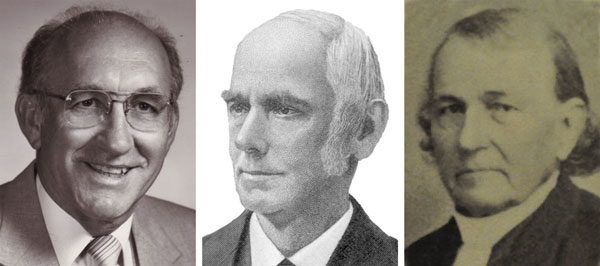07 Jun On This Day in UB History: June 7, 1992 (Canada)

Three bishops influential in the history of the United Brethren Church in Canada (l-r): C. Ray Miller, John Jacob Glossbrenner, and Jacob Erb.
On June 7, 1992, Bishop C. Ray Miller officially established the United Brethren Church in Canada. For nearly 20 years, he had been bishop of the UB churches in Canada. But no more. Now they were a self-governing national conference–the first in our denomination.
Bishop Miller was, sort of, the second bishop to establish the Canadian conference.
John Jacob Glossbrenner served as bishop 1845-1885. That’s 40 years, which is longer (by 12 years) than any other United Brethren bishop. So he did a lot of things during his tenure. One of which was organizing a conference in Canada. That happened on April 19, 1856.
United Brethrenism in Canada developed in a hodgepodge sort of way, and involved an assortment of people.
A non-UB named John Cornell, from the “Cornell University” family, moved to Ontario in 1800 and spent the rest of his life as a preacher there. He started a number of churches.
Jacob Erb, a United Brethren minister from Ohio, was sent by his home conference, Pennsylvania, as a missionary to Canada around 1825. He preached and scattered a lot of seed, but didn’t organize any churches. He went back and forth, but had a continuing relationship with Canada. Erb was elected bishop in 1837 at the ripe old age of 33. He served eight years, took four years off, and then served another term, 1849-1853.
Bishop Christian Newcomer crossed into Canada in 1826 and preached at Fort Erie, right across the border from Buffalo. Some UBs had apparently immigrated to Canada, because Newcomer mentioned meeting “many acquaintances whom I had not seen for many years.”
Which brings us back to John Cornell. In 1854, Cornell, now a 72-year-old, began considering retirement. What would become of his scattered congregations? He met with Jacob Erb, liked what he heard about the United Brethren church, and brought his churches under the UB umbrella.
Two years later, Bishop Glossbrenner officially organized the Canada Mission Conference. There were eight ordained ministers—four Americans, and four Canadians (including John Cornell and his son, William)—plus one other licensed minister. The minutes from 1856 showed 152 members among 18 preaching appointments and seven organized churches. Growth came quickly. By 1863, membership had hit 1000.
What exactly did Bishop Miller do in 1992? He established the Canadian churches as a separate national conference. They had always been Ontario Conference, just another annual conference governed out of an office in Indiana. That went against Canadian laws. To retain their charitable status, our Canadian churches needed to be self-governing with their own Constitution. All UB national conferences are now set up this way.
So, Canada owns two firsts: our first conference outside of the United States, and our first national conference.

No Comments